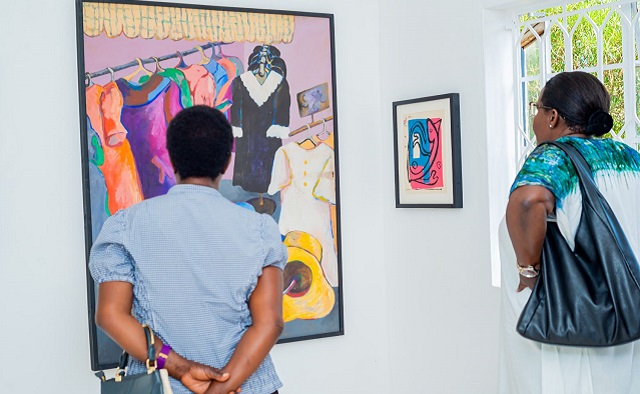
The selected artworks in the exhibition Imparted Impressions depict the artist’s distinctive style of painting influenced by European modernist art making techniques but also a delicate sense of freedom in choice of material, composition and subject matter.
ART | DOMINIC MUWANGUZI | To say that Lydia Mugambi is one of the senior underrated artists in Uganda is not an understatement. This is mostly because her name has not made waves like some of her contemporaries like, Theresa Musoke who graduated from Margret Trowell School of Fine art in its early years. If her name raises any form of familiarity within the arts, it will be probably because of her love for theatre where she equally excelled as a talented actor in several stage plays at the National Theatre. But her forte as an accomplished artist and educator is probably what still stands out, especially when one encounters with her classical collection of her personal works on display at Xenson Artspace. The exhibition Imparted Impressions: A Retrospective of Lydia Mugambi sheds a spotlight on the artist’s illustrious career marked with a venture into multidisciplinary art forms but also celebrates her personality as a resilient, hardworking, inspirational, and innovative woman artist of her generation.
Mugambi’s extensive collection suggests an artist who’s a social commentator through her work. Her paintings, sculptures and prints eloquently convey the realities and aspirations of her immediate surroundings. This is often interwoven with different types of imagery and motifs which communicate her very powerful expressive visual language. For example, she mostly uses pure colours, a common style of painting reminiscent in many paintings of senior artists from Makerere art school, as a medium to convey her messages effectively to her audience. Equally, this tradition of working with colour sparingly seems to allude to the scarcity of painting material in the country at the time that was mostly precipitated by political turmoil. On the other hand, most of her paintings are in abstract form, revealing to her audience the influence of European techniques of art making which were highly emphasized at the institution during her time there.

But a critical encounter with some of her works reveal a certain level of independence, especially within the aspect of composition, material and subject matter. She draws on her technical competence of drawing the human figure, a recurring motif in her works, as a figurative representation of the human condition and experience she interrogates through her work. As such her commentary on the social and sometimes political terrain of her motherland is not abstract in the eyes and minds of her audience. The human figure becomes at once an entry point into the artwork, facilitating the viewer to understand and relate with the message being passed on. Similarly, her sculptural works suggest an artist who is ardent to pay attention to the ongoing conversations around the subject of woman identity in the contemporary world. This is a very interesting path to take on for the veteran artist who many may assume to be disinterested in such a “fashionable” topic. Yet through such interrogation, she’s able to delicately subvert the stereotype on the female gender. In fact, her profession as a woman artist is a symbol of challenging the prejudice around women as solely caretakers of a home and not workers.
The different artistic approaches with or on different mediums like ink, paper, canvas and Dutch-wax (kitegi fabric) offer a much deeper conversation on her technical competence and adeptness to experiment. While the latter aspect may be thought to be a new phenomenon on the contemporary art scene, Mugambi demonstrates to us in her collection that she probably could be one of the pioneers of this movement of pushing the boundaries of art through experimentation . Conversely, this approach in her artwork facilitates her freedom of expression where each medium can be used to convey different types of messages to different types of audiences. Here, it becomes obvious that the artist pays as much attention to her audience as she does to the art making. She therefore underpins the notion that the artwork is never complete until it gets an audience.
Mugambi’s artistic legacy is one that is undisputed. Her technical prowess, creative agility and individuality are presented to us in this exhibition that seeks to expose, engage and educate both the young and established artists. For the young artists, Mugambi’s legacy provides immense inspiration to succeed against all odds. The artist chose a male dominated profession and excelled in it, despite the challenges which were attached to the vocation at the time. On the other hand, the established artists can learn from her versatility as she took on different careers besides art teaching and making. This has enabled her to be economically independent even in retirement but also look healthy and vibrant. As such the many facets of this exhibition, give it an enduring resonance to the different types of audiences that attended its opening and those that will continue to interact with it during the time it will remain open.
*****
The exhibition Imparted Impressions: A Retrospective of Lydia Mugambi is part of the emerging curators program by Xenson Artspace in partnership with British Council. The exhibition is curated by Maria Olivia Nakato.
 The Independent Uganda: You get the Truth we Pay the Price
The Independent Uganda: You get the Truth we Pay the Price

